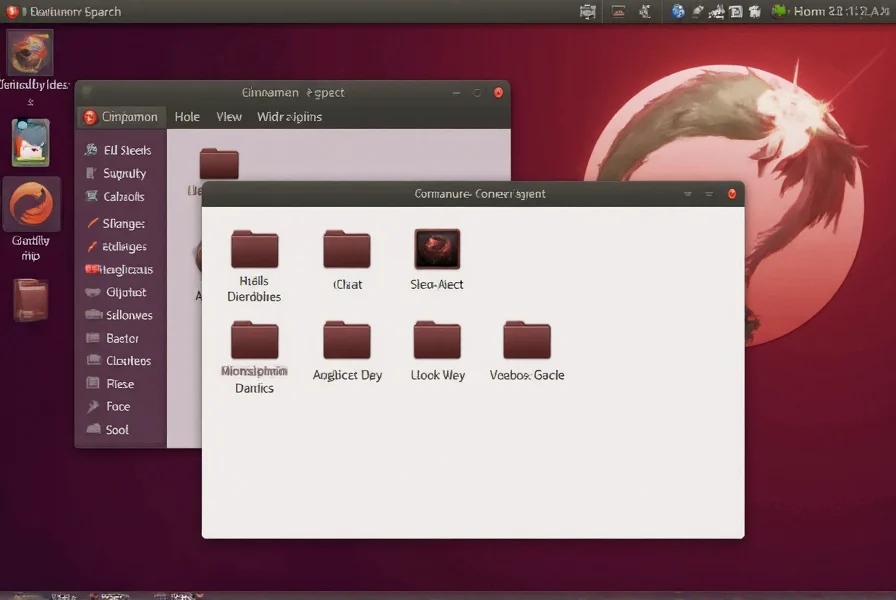For Linux enthusiasts seeking a balance between cutting-edge technology and intuitive interface design, Cinnamon Anarchy presents an intriguing option. This Arch-based distribution delivers the stability and familiarity of the Cinnamon desktop environment while leveraging Arch Linux's powerful package management system and rolling release cycle. The result is a desktop experience that combines the best of both worlds: the visual appeal and ease of use that made Cinnamon popular in Linux Mint, with the bleeding-edge software updates characteristic of Arch-based systems.
Understanding Cinnamon Anarchy's Technical Foundation
Cinnamon Anarchy builds upon Arch Linux's solid foundation, which means it inherits several key characteristics that distinguish it from other Cinnamon implementations. The distribution follows Arch's "keep it simple" philosophy while adding the visual polish of the Cinnamon desktop. Unlike Linux Mint's Cinnamon edition, which uses Ubuntu as its base and follows a traditional release cycle, Cinnamon Anarchy provides continuous updates through Arch's package repositories.
One of the most significant technical differences lies in the installation process. While Linux Mint offers a straightforward graphical installer, Cinnamon Anarchy requires users to be comfortable with command-line installation procedures typical of Arch-based distributions. This makes it more suitable for intermediate to advanced Linux users who value customization and control over their system.
Key Features That Set Cinnamon Anarchy Apart
What truly distinguishes Cinnamon Anarchy from other Cinnamon-based distributions are its specific configuration choices and additional components:
- Arch Linux base - Provides access to the Arch User Repository (AUR) with thousands of additional packages
- Rolling release model - Continuous updates without major version upgrades
- Pre-configured Cinnamon experience - Optimized settings that differ from standard Cinnamon implementations
- Community-driven development - Focused on user feedback and specific workflow enhancements
- Lightweight resource usage - More efficient than many other desktop environments while maintaining visual appeal
| Feature | Cinnamon Anarchy | Linux Mint Cinnamon |
|---|---|---|
| Base Distribution | Arch Linux | Ubuntu |
| Release Model | Rolling Release | Fixed Release |
| Installation Complexity | Intermediate/Advanced | Beginner-Friendly |
| Package Management | pacman + AUR | APT |
| Default Software Selection | Minimal base + Cinnamon-specific tools | Comprehensive suite of pre-installed applications |
Installation Process and System Requirements
Installing Cinnamon Anarchy follows Arch Linux's manual installation process, which differs significantly from the graphical installers found in user-friendly distributions like Linux Mint. Users must partition disks, configure the system through command-line interfaces, and manually install the Cinnamon desktop environment along with necessary drivers and applications.
For those considering how to install Cinnamon Anarchy, the minimum system requirements include:
- 64-bit x86 processor (1 GHz or faster)
- 2 GB RAM (4 GB recommended for comfortable usage)
- 20 GB of free disk space
- Internet connection for package installation
- Basic understanding of Linux command line
The installation process typically takes experienced users about 30-45 minutes, though beginners may require more time to complete the setup properly. Unlike standard Cinnamon distributions, Cinnamon Anarchy doesn't offer a live environment for testing before installation.
User Experience and Interface Design
The Cinnamon desktop environment in Cinnamon Anarchy maintains the traditional desktop metaphor that made it popular, featuring a bottom panel with application menu, system tray, and window list. However, the Anarchy variant includes several distinctive customizations:
- Unique theme - A custom color scheme and icon set that differentiates it from standard Cinnamon
- Pre-configured applets - Thoughtfully selected panel applets that enhance productivity
- Optimized default applications - Carefully chosen software that complements the desktop experience
- Enhanced window management - Additional tiling options and workspace behaviors
One notable aspect of Cinnamon Anarchy user experience is how it balances simplicity with advanced features. The desktop remains accessible to users transitioning from Windows while providing the customization depth that Linux enthusiasts appreciate. The settings panel offers extensive configuration options without overwhelming beginners with too many choices at once.
Performance Considerations for Different Hardware
Cinnamon Anarchy performs well across various hardware configurations, though results vary based on system specifications. On modern hardware (8th generation Intel processors or newer), the desktop environment runs smoothly with excellent responsiveness. Even on older hardware (6th generation Intel or equivalent AMD), Cinnamon Anarchy remains usable with some minor performance considerations.
When comparing Cinnamon Anarchy vs standard Cinnamon performance, the Arch base generally provides better resource management, though the visual effects in Cinnamon can still be demanding on very old hardware. Users with limited RAM may want to disable certain visual effects through the desktop settings to improve performance.
Who Should Consider Using Cinnamon Anarchy?
Cinnamon Anarchy serves a specific niche within the Linux community. It's particularly well-suited for:
- Experienced Linux users who appreciate Cinnamon's interface but want Arch's rolling release model
- Users migrating from Linux Mint who want more up-to-date software packages
- Intermediate users comfortable with command-line operations but seeking a polished desktop experience
- Those who value system customization without sacrificing usability
However, it may not be the best choice for complete Linux beginners who would benefit more from distributions with graphical installers and more comprehensive documentation. The learning curve associated with Arch-based systems makes Cinnamon Anarchy better suited for users with some prior Linux experience.
Troubleshooting Common Issues
Like any Linux distribution, users may encounter specific challenges with Cinnamon Anarchy. Common issues and their solutions include:
- Wi-Fi connectivity problems - Install appropriate firmware packages using pacman
- Graphics driver issues - Install proprietary drivers through the Arch repositories
- Missing codecs - Enable the multilib repository and install necessary packages
- Panel configuration resets - Backup configuration files in ~/.cinnamon before major updates
The Arch Wiki serves as an invaluable resource for troubleshooting Cinnamon Anarchy issues, as most solutions for Arch Linux apply directly to this distribution. The community forums also provide specific guidance for Cinnamon-related configuration questions.

Future Development and Community Support
The development of Cinnamon Anarchy follows the broader trends in both the Cinnamon desktop environment and Arch Linux ecosystem. Recent updates have focused on improving Wayland support, though X11 remains the default display server for better compatibility. The community actively works on refining the default configuration to provide an out-of-the-box experience that requires minimal tweaking for most users.
Community support for Cinnamon Anarchy comes primarily through dedicated forums and IRC channels, with additional resources available through the broader Arch Linux and Cinnamon communities. Unlike commercially backed distributions, support relies on volunteer contributions, though the knowledgeable community typically provides timely assistance for most issues.
Practical Recommendations for Potential Users
For those considering whether Cinnamon Anarchy is right for their needs, here are some practical recommendations:
- Test with a virtual machine before committing to a full installation
- Review the Arch installation guide thoroughly before beginning
- Join the community forums to understand current development priorities
- Consider your hardware specifications and whether they meet the requirements
- Evaluate your comfort level with command-line operations and system configuration
Remember that while Cinnamon Anarchy offers a unique blend of features, it represents just one option in the diverse Linux ecosystem. Your specific workflow requirements, hardware capabilities, and technical comfort level should guide your decision when exploring best Linux distributions with Cinnamon desktop.
What is the main difference between Cinnamon Anarchy and Linux Mint Cinnamon?
The primary difference is the base distribution: Cinnamon Anarchy uses Arch Linux with a rolling release model, while Linux Mint Cinnamon is based on Ubuntu with fixed releases. This means Cinnamon Anarchy provides more frequent software updates but requires more technical knowledge to install and maintain.
Is Cinnamon Anarchy suitable for beginners?
Cinnamon Anarchy is generally not recommended for complete Linux beginners due to its Arch-based installation process, which requires command-line proficiency. Users should have some prior Linux experience before attempting to install and configure Cinnamon Anarchy.
Can I customize the Cinnamon desktop in Cinnamon Anarchy?
Yes, Cinnamon Anarchy offers extensive customization options similar to standard Cinnamon. Users can modify themes, applets, desklets, and various interface elements through the System Settings menu or by installing additional extensions from the Cinnamon Spices repository.
How often does Cinnamon Anarchy receive updates?
As an Arch-based distribution, Cinnamon Anarchy follows a rolling release model, meaning it receives continuous updates. Security patches and software updates are typically available within days of their release, providing users with the latest features and security improvements without requiring major version upgrades.
Does Cinnamon Anarchy support proprietary software and drivers?
Yes, Cinnamon Anarchy supports proprietary software and drivers through the Arch User Repository (AUR) and official repositories. Users can install NVIDIA drivers, Steam, Spotify, and other proprietary applications following standard Arch Linux procedures.
Conclusion
Cinnamon Anarchy fills a specific niche for Linux users who appreciate the Cinnamon desktop environment but want the benefits of an Arch-based system. It successfully bridges the gap between user-friendly desktop environments and the power of Arch Linux, offering a compelling option for intermediate to advanced users. While it requires more technical knowledge than distributions like Linux Mint, the payoff is a highly customizable system with up-to-date software and the familiar Cinnamon interface that many users prefer over more radical desktop environments.
For those willing to invest the time in installation and configuration, Cinnamon Anarchy delivers a polished desktop experience that combines the best elements of the Cinnamon interface with Arch Linux's robust foundation. As with any Linux distribution, the best way to determine if it meets your needs is to try it in a virtual machine or on secondary hardware before committing to a full installation.











 浙公网安备
33010002000092号
浙公网安备
33010002000092号 浙B2-20120091-4
浙B2-20120091-4